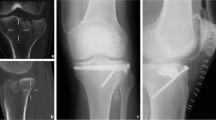Abstract
Introduction
Periprosthetic tibial plateau fractures (TPF) are rare but represent a serious complication in unicompartmental knee arthroplasty. The most common treatment for these fractures is osteosynthesis with cannulated screws or plates. The aim of this study was to evaluate two different treatment options for periprosthetic fractures. The hypothesis was that angle-stable plates show significantly higher fracture loads than fixation with cannulated screws.
Materials and methods
Twelve matched, paired fresh-frozen tibiae with periprosthetic TPF were used for this study. In Group A, osteosyntheses with cannulated screws were performed, whereas in Group B plates fixated the periprosthetic fracture. DEXA bone density measurement and standard X-rays (AP and lateral) were performed before loading the tibiae under standardised conditions with a maximum load of up to 10.0 kN. After the specimens had been loaded, fracture patterns and fracture loads were analysed and correlated with BMD, BMI, bodyweight (BW), age and size of the tibial implant.
Results
In the plate group all tibiae fracture occured with a median load of F max = 2.64 (0.45–5.68) kN, whereas in the group with cannulated screws fractures occurred at a mean load of F max = 1.50 (0.27–3.51) kN. The difference was statistically significant at p < 0.05.
Discussion
Angle-stable plates showed significantly higher fracture loads than fixation with cannulated screws. Cannulated screws show a reduced stability of the tibial plateau. Therefore in periprosthetic TPF, osteosyntheses with angle-stable plates should be recommended instead of cannulated screws.




Similar content being viewed by others
References
Aldinger PR, Clarius M, Murray DW, Goodfellow JW, Breusch SJ (2004) Medial unicompartmental knee replacement using the “Oxford Uni” meniscal bearing knee. Der Orthopade 33(11):1277–1283. doi:10.1007/s00132-004-0712-6
Price AJ, Waite JC, Svard U (2005) Long-term clinical results of the medial oxford unicompartmental knee arthroplasty. Clin Orthop Rel Res 435:171–180
Riddle DL, Jiranek WA, McGlynn FJ (2008) Yearly incidence of unicompartmental knee arthroplasty in the United States. J Arthroplast 23(3):408–412. doi:10.1016/j.arth.2007.04.012
Svard UC, Price AJ (2001) Oxford medial unicompartmental knee arthroplasty. A survival analysis of an independent series. J Bone Jt Surg British Vol 83(2):191–194
Registry AOANJR (2008) Annual Report 2008. AOA, Adelaide
Rudol G, Jackson MP, James SE (2007) Medial tibial plateau fracture complicating unicompartmental knee arthroplasty. J Arthroplast 22(1):148–150. doi:10.1016/j.arth.2006.01.005
Hanssen AD, Stuart MJ (2000) Treatment of periprosthetic tibial fractures. Clin Orthop Relat Res 380:91–98
Berger RA, Meneghini RM, Jacobs JJ, Sheinkop MB, Della Valle CJ, Rosenberg AG, Galante JO (2005) Results of unicompartmental knee arthroplasty at a minimum of ten years of follow-up. J Bone Jt Surg Am Vol 87(5):999–1006. doi:10.2106/JBJS.C.00568
Levine WN, Ozuna RM, Scott RD, Thornhill TS (1996) Conversion of failed modern unicompartmental arthroplasty to total knee arthroplasty. J Arthroplast 11(7):797–801
Biggi F, Di Fabio S, D’Antimo C, Trevisani S (2010) Tibial plateau fractures: internal fixation with locking plates and the MIPO technique. Injury 41(11):1178–1182. doi:10.1016/j.injury.2010.08.001
Lobenhoffer P, Schulze M, Tscherne H (1996) Minimally invasive osteosynthesis of fractures of the tibial head. Der Unfallchirurg 99(8):569–575
Tsuji T, Kitano K, Yamano Y, Sato T, Koike T (2001) Distribution of bone mineral density in the proximal tibia in mid-teens. J Bone Miner Metab 19(5):324–328. doi:10.1007/s0077410190324
Clarius M, Aldinger PR, Bruckner T, Seeger JB (2009) Saw cuts in unicompartmental knee arthroplasty: an analysis of Sawbone preparations. Knee 16(5):314–316. doi:10.1016/j.knee.2008.12.018
Clarius M, Haas D, Aldinger PR, Jaeger S, Jakubowitz E, Seeger JB (2010) Periprosthetic tibial fractures in unicompartmental knee arthroplasty as a function of extended sagittal saw cuts: an experimental study. Knee 17(1):57–60. doi:10.1016/j.knee.2009.05.004
Seeger JB, Haas D, Jager S, Rohner E, Tohtz S, Clarius M (2011) Extended sagittal saw cut significantly reduces fracture load in cementless unicompartmental knee arthroplasty compared to cemented tibia plateaus: an experimental cadaver study. Knee Surg Sports Traumatol Arthrosc : Off J ESSKA. doi:10.1007/s00167-011-1698-3
Cift H, Cetik O, Kalaycioglu B, Dirikoglu MH, Ozkan K, Eksioglu F (2010) Biomechanical comparison of plate-screw and screw fixation in medial tibial plateau fractures (Schatzker 4). A model study. Orthop Traumatol Surg Res: OTSR 96(3):263–267. doi:10.1016/j.otsr.2009.11.016
Perren SM (2002) Evolution of the internal fixation of long bone fractures. The scientific basis of biological internal fixation: choosing a new balance between stability and biology. J Bone Jt Surg British Vol 84(8):1093–1110
Frigg R, Appenzeller A, Christensen R, Frenk A, Gilbert S, Schavan R (2001) The development of the distal femur Less Invasive Stabilization System (LISS). Injury 32(3):SC24–SC31
Krettek C (1997) Foreword: concepts of minimally invasive plate osteosynthesis. Injury 28(Suppl 1):A1–A2
Goesling T, Frenk A, Appenzeller A, Garapati R, Marti A, Krettek C (2003) LISS PLT: design, mechanical and biomechanical characteristics. Injury 34(Suppl 1):A11–A15
Messmer P, Regazzoni P, Gross T (2003) New stabilization techniques for fixation of proximal tibial fractures (LISS/LCP). Therapeutische Umschau Revue therapeutique 60(12):762–767
Conflict of interest
The study was partially supported by Biomet, and the authors of the study disclose the following financial relationships to the company: Dr Clarius serves as a paid consultant for Aesculap and Biomet and has received research or institutional support from Biomet. However, neither Aesculap nor Biomet exerted any influence on the study methods, results, or interpretation of the data. The study was supported by a research grant from the University of Heidelberg.
Author information
Authors and Affiliations
Corresponding author
Rights and permissions
About this article
Cite this article
Seeger, J.B., Jaeger, S., Röhner, E. et al. Treatment of periprosthetic tibial plateau fractures in unicompartmental knee arthroplasty: plates versus cannulated screws. Arch Orthop Trauma Surg 133, 253–257 (2013). https://doi.org/10.1007/s00402-012-1649-6
Received:
Published:
Issue Date:
DOI: https://doi.org/10.1007/s00402-012-1649-6




